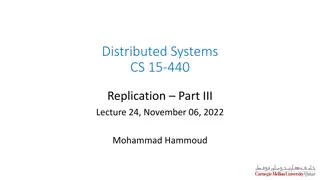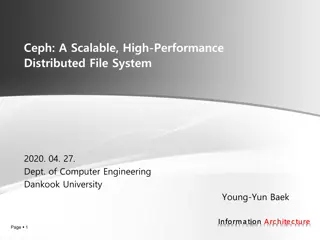Understanding WAFL: Write Anywhere File System in Distributed Systems
Explore the concept of WAFL in distributed systems, where appliances are preferred over general-purpose computers. WAFL addresses the unique requirements of NFS file servers, emphasizing fast performance, support for large file systems, and efficient write operations through Copy-on-write snapshots. Learn how WAFL boosts system reliability, ease of recovery, and data protection in network environments.
Download Presentation

Please find below an Image/Link to download the presentation.
The content on the website is provided AS IS for your information and personal use only. It may not be sold, licensed, or shared on other websites without obtaining consent from the author. Download presentation by click this link. If you encounter any issues during the download, it is possible that the publisher has removed the file from their server.
E N D
Presentation Transcript
CS 202 Advanced OS WAFL: Write Anywhere File System
Presentation credit: Mark Claypool from WPI. WAFL: WRITE ANYWHERE FILE SYSTEMS
Introduction In general, an appliance is a device designed to perform a specific function Distributed systems trend has been to use appliances instead of general purpose computers. Examples: routers from Cisco and Avici network terminals network printers New type of network appliance is an Network File System (NFS) file server
Introduction : NFS Appliance NFS File Server Appliance file systems have different requirements than those of a general purpose file system NFS access patterns are different than local file access patterns Large client-side caches result in fewer reads than writes Network Appliance Corporation uses a Write Anywhere File Layout (WAFL) file system
Introduction : WAFL WAFL has 4 requirements Fast NFS service Support large file systems (10s of GB) that can grow (can add disks later) Provide high performance writes and support Redundant Arrays of Inexpensive Disks (RAID) Restart quickly, even after unclean shutdown NFS and RAID both strain write performance: NFS server must respond after data is written RAID must write parity bits also
Outline Introduction Snapshots : User Level WAFL Implementation Snapshots: System Level Performance Conclusions (done) (next)
Introduction to Snapshots Snapshots are a copy of the file system at a given point in time WAFL s claim to fame WAFL creates and deletes snapshots automatically at preset times Up to 255 snapshots stored at once Uses Copy-on-write to avoid duplicating blocks in the active file system Snapshot uses: Users can recover accidentally deleted files Sys admins can create backups from running system System can restart quickly after unclean shutdown Roll back to previous snapshot
User Access to Snapshots Example, suppose accidentally removed file named todo : spike% ls -lut .snapshot/*/todo -rw-r--r-- 1 hitz 52880 Oct 15 00:00 .snapshot/nightly.0/todo -rw-r--r-- 1 hitz 52880 Oct 14 19:00 .snapshot/hourly.0/todo -rw-r--r-- 1 hitz 52829 Oct 14 15:00 .snapshot/hourly.1/todo -rw-r--r-- 1 hitz 55059 Oct 10 00:00 .snapshot/nightly.4/todo -rw-r--r-- 1 hitz 55059 Oct 9 00:00 .snapshot/nightly.5/todo Can then recover most recent version: spike% cp .snapshot/hourly.0/todo todo Note, snapshot directories (.snapshot) are hidden in that they don t show up with ls
Snapshot Administration The WAFL server allows commands for sys admins to create and delete snapshots, but typically done automatically At WPI, snapshots of /home: 7:00 AM, 10:00, 1:00 PM, 4:00, 7:00, 10:00, 1:00 AM Nightly snapshot at midnight every day Weekly snapshot is made on Sunday at midnight every week Thus, always have: 7 hourly, 7 daily snapshots, 2 weekly snapshots claypool 32 ccc3=>>pwd /home/claypool/.snapshot claypool 33 ccc3=>>ls hourly.0/ hourly.3/ hourly.6/ nightly.2/ nightly.5/ weekly.1/ hourly.1/ hourly.4/ nightly.0/ nightly.3/ nightly.6/ hourly.2/ hourly.5/ nightly.1/ nightly.4/ weekly.0/
Outline Introduction (done) Snapshots : User Level (done) WAFL Implementation (next) Snapshots: System Level Performance Conclusions
WAFL File Descriptors Inode based system with 4 KB blocks Inode has 16 pointers For files smaller than 64 KB: Each pointer points to data block For files larger than 64 KB: Each pointer points to indirect block For really large files: Each pointer points to doubly-indirect block For very small files (less than 64 bytes), data kept in inode instead of pointers
WAFL Meta-Data Meta-data stored in files Inode file stores inodes Block-map file stores free blocks Inode-map file identifies free inodes
Zoom of WAFL Meta-Data (Tree of Blocks) Root inode must be in fixed location Other blocks can be written anywhere
Snapshots (1 of 2) Copy root inode only, copy on write for changed data blocks Over time, old snapshot references more and more data blocks that are not used Rate of file change determines how many snapshots can be stored on the system
Snapshots (2 of 2) When disk block modified, must modify indirect pointers as well Batch, to improve I/O performance
Consistency Points (1 of 2) In order to avoid consistency checks after unclean shutdown, WAFL creates a special snapshot called a consistency point every few seconds Not accessible via NFS Batched operations are written to disk each consistency point In between consistency points, data only written to RAM
Consistency Points (2 of 2) WAFL use of NVRAM (NV = Non-Volatile): (NVRAM has batteries to avoid losing during unexpected poweroff) NFS requests are logged to NVRAM Upon unclean shutdown, re-apply NFS requests to last consistency point Upon clean shutdown, create consistency point and turnoff NVRAM until needed (to save batteries) Note, typical FS uses NVRAM for write cache Uses more NVRAM space (WAFL logs are smaller) Ex: rename needs 32 KB, WAFL needs 150 bytes Ex: write 8KB needs 3 blocks (data, inode, indirect pointer), WAFL needs 1 block (data) plus 120 bytes for log Slower response time for typical FS than for WAFL
Write Allocation Write times dominate NFS performance Read caches at client are large 5x as many write operations as read operations at server WAFL batches write requests WAFL allows write anywhere, enabling inode next to data for better perf Typical FS has inode information and free blocks at fixed location WAFL allows writes in any order since uses consistency points Typical FS writes in fixed order to allow fsck to work
Outline Introduction (done) Snapshots : User Level (done) WAFL Implementation (done) Snapshots: System Level (next) Performance Conclusions
The Block-Map File Typical FS uses bit for each free block, 1 is allocated and 0 is free Ineffective for WAFL since may be other snapshots that point to block WAFL uses 32 bits for each block
Creating Snapshots Could suspend NFS, create snapshot, resume NFS But can take up to 1 second Challenge: avoid locking out NFS requests WAFL marks all dirty cache data as IN_SNAPSHOT. Then: NFS requests can read system data, write data not IN_SNAPSHOT Data not IN_SNAPSHOT not flushed to disk Must flush IN_SNAPSHOT data as quickly as possible
Flushing IN_SNAPSHOT Data Flush inode data first Keeps two caches for inode data, so can copy system cache to inode data file, unblocking most NFS requests (requires no I/O since inode file flushed later) Update block-map file Copy active bit to snapshot bit Write all IN_SNAPSHOT data Restart any blocked requests Duplicate root inode and turn off IN_SNAPSHOT bit All done in less than 1 second, first step done in 100s of ms
Outline Introduction (done) Snapshots : User Level (done) WAFL Implementation (done) Snapshots: System Level (done) Performance (next) Conclusions
Performance (1 of 2) Compare against NFS systems Best is SPEC NFS LADDIS: Legato, Auspex, Digital, Data General, Interphase and Sun Measure response times versus throughput (Me: System Specifications?!)
Performance (2 of 2) (Typically, look for knee in curve)
NFS vs. New File Systems 14 10 MPFS Clients 12 Response Time (Msec/Op) 5 MPFS Clients & 5 NFS Clients 10 NFS Clients 10 8 6 4 2 0 0 1000 2000 3000 4000 5000 Generated Load (Ops/Sec) Remove NFS server as bottleneck Clients write directly to device
Conclusion NetApp (with WAFL) works and is stable Consistency points simple, reducing bugs in code Easier to develop stable code for network appliance than for general system Few NFS client implementations and limited set of operations so can test thoroughly























